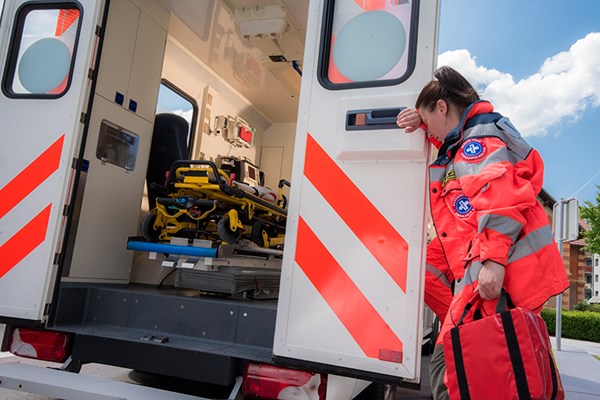As resident doctors, we are tasked with leading resuscitations, explaining our thought processes, and debriefing our team. But how often do we include our pre-hospital peers?
I was awaiting the arrival of a pediatric trauma code. My mind ran through the systematic algorithms I had learned to apply in my sterile, controlled trauma bay. The respiratory therapist was bedside, equipment in hand, techs lined up waiting to do compressions as the pulseless patient arrived. We ran like clockwork through our ABCs, ROSC was achieved, the patient was stabilized, and then sent to the OR. I updated the family and returned to the ED, only to meet a shaken EMS crew with more questions than answers.
These were the paramedics called to the scene of a pulseless 7-year-old child in a cage of twisted steel with a nearby mother in hysterics. Compressions were initiated, intubation was attempted but deferred for an LMA when it proved to be difficult. The first few rounds of epinephrine were administered. They were anxious to hear what else they could have done.
I could empathize with how they were feeling. I spent 5 years in the fire department prior to entering medical school. I remember feeling desperate for those answers and some sense of closure. I spent many sleepless nights wondering if I had made the right call, given the right medication, or told the patient the right thing. I was always grateful to those doctors who took the time to teach me and make me a better paramedic.
She is in the operating room now. That LMA was working perfectly. I don't think there is anything else you could have done.
They thanked me. I thanked them. Then they left to return to service.
As resident doctors, we are tasked with leading resuscitations, explaining our thought processes, and debriefing our team. All too often our pre-hospital peers are forgotten members of this team.
According to a study by Cash et al. of more than 15,000 responses from pre-hospital providers, only two-thirds of paramedics and EMTs reported receiving feedback regarding patient care when asked about interactions over a month’s span. Most of this feedback (70.9%) came from crew members, while only 57.4% came from receiving facility staff.1 Meanwhile, in a study by Lena et al., EMS personnel did not recognize sepsis nearly 40% of the time in patients who were later confirmed septic in the ED.2 While this can be attributed to the fact that EMS does not have nearly the diagnostic tools or the clinical acumen that a well-staffed ED does, it highlights the fact that there are many opportunities to explain diagnoses or follow up with crews regarding patient outcomes.
When I first encountered these shaken medics in the trauma bay, I was a new intern who had just run my first pediatric code. I was wildly unprepared to lead a debrief. But to the paramedics, I was the higher level of care and, therefore, a teacher.
Assessing the need and providing feedback to prehospital providers should be a vital part of our training in residency. This can be as simple as updating them on the subsequent activities in the trauma bay. Other times it may be prudent to give feedback to correct an error, explain a diagnosis, or suggest ways they could improve their procedural skills. Distressing and traumatic scenarios should always warrant some sort of follow-up whenever possible.
There are many systems constraints that make providing feedback in the ED difficult. While ambulance ride-alongs are a component of most residency programs, these experiences are often insufficient for developing insight into EMS's role in patient care, their level of training, or their protocols. This prevents us from adequately teaching prehospital providers. Even when we are knowledgeable enough to offer some education, we are often juggling multiple patients and do not have the time to circle back around. There is seldom an appropriate space to have this conversation even when we do find the time.
We can bridge this gap by making an effort to be involved in EMS training and taking the time to build relationships with area fire departments. On a hospital-wide scale, there can be efforts made to facilitate this feedback process including creating physical spaces for discussion. Paramedics should be encouraged to follow-up to receive patient updates, and there should be a streamlined way for them to reach the hospital providers to ask questions. This can be as simple as giving the paramedic the hospital phone number and encouraging them to call and check in on their patient.
Take the time to thank our pre-hospital brethren. Tell them what happened to the abdominal pain patient they dropped off at their last shift. Show them why you are concerned about the ST elevation in aVR. Point out the pneumothorax on a chest x-ray and show them where you would do the needle decompression. Correct them if you notice medication errors. If they made the right call and you would have done nothing differently, let them know. Make an effort to educate yourself and others about their training level and their environmental constraints. We can all play a role in helping our EMS peers grow to provide better care for the sake of all of our patients.
(The author would like to thank Geoff Comp, DO, FAWM, of Creighton/Maricopa Medical center for his mentorship, as well as Jeffrey Tomaszeski, RN, of the Mayo Clinic for his insight.)
References
- Cash RE, Crowe RP, Rodriguez SA, et al. Disparities in feedback provision to emergency medical services professionals. Emergency Care.2017;21:773–781.
- Lena C. W. van der Wekken, etal. (2016) Epidemiology of sepsis and Its recognition by emergency medical services personal in the Netherlands. Prehospital Emergency Care.



